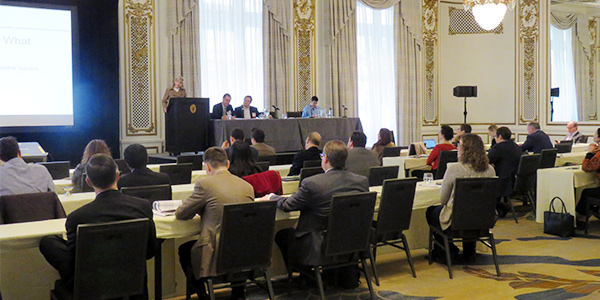By Hudson Sangree
SAN FRANCISCO — The former president of the California Public Utilities Commission told a gathering of energy lawyers Friday that common assumptions about the future of renewable energy and electrification need to be re-examined.
Michael Picker, who left the commission in summer 2019, was replaced by Marybel Batjer. Since then, Picker said he’s been working for Gov. Gavin Newsom, putting together an energy roadmap for the state as it tries to reach its ambitious renewable energy and greenhouse gas reduction goals by midcentury. (See Retiring CPUC President Still Has Lots to Say.)
His research has led him to new thinking about reliability and resilience, he told the Western Chapter of the Energy Bar Association at its annual meeting. Picker was the keynote speaker, and his thought-provoking presentation was discussed throughout the day’s proceedings.
For instance, Picker said the idea that the state’s biggest utilities are opposed to clean energy, while community choice aggregators are more progressive, doesn’t pan out in the math.
The state’s investor-owned utilities — the “much maligned” Pacific Gas and Electric, Southern California Edison and San Diego Gas & Electric — had achieved renewable portfolio compliance of 40%, 36% and 41%, respectively, by the end of 2018, he said.
“So that’s not bad progress since the goal was 30% by 2020,” Picker said. “And if you look at the forward compliance, each of them expects to be at 52% or above by 2024.”
Under Senate Bill 100, passed in 2018, the IOUs are expected to achieve primary reliance on clean energy sources by 2045.
Community choice aggregators (CCAs), most of which promise clean energy to retail customers and will become the majority of load-serving entities in coming decades, are falling behind, he said. They’ve proven more reliant on short-term contracts with out-of-state generators, with transmission constraints between source and sink, he said.
The IOUs, with more capital available, have been more successful in signing long-term contracts with in-state generators, whereas the “smaller entities [such as CCAs] with thinner capitalization have had a harder time being able to make those investments in long-term contracts,” he said. (See Calif. Lawmakers Reveal Growing Divisions over CCAs.)
Another issue, Pickers said, is that time-of-day demand from residential and commercial customers is merging.
California’s aerospace and automobile manufacturing economy died away, he said. Those industries used electricity around the clock, working three shifts every 24 hours. Now the state has a lot of “computational-based industries” that mirror household demand, with peaks about 200 hours out of the year, mainly after 5 p.m. on weekdays, he said.
“Who wants to build a power plant that’s only going to be selling electricity for 200 hours per year?” Picker said. “And how do you do that with solar if some of that demand is in the evenings after the effective capacity of solar starts to decline as the sun’s going down to the horizon?”
Rethinking EVs
Picker also noted that there’s a common misconception that generators are responsible for the bulk of greenhouse gas emissions. Electricity generation is responsible for 15% of carbon emissions, whereas transportation is responsible for 40%, he said.
State law requires a reduction in greenhouse gases by 40% below 1990 levels by 2030.
“As the electricity supply gets cleaner, it’s harder to reach that 2030 goal simply on the backs of the electric industry,” Picker said. “We have to address transportation.”
Statutes set a goal of having 2.5 million electric vehicles on California’s roads by 2025, he said. But planners tend to focus on individual ownership of EVs.
“There’s an implicit assumption amongst many of the planners that transportation is going to look the same 20 years from now as 20 years before,” he said. “Most of the policy … is focused on single ownership cars.”
In some urban areas, including Sacramento, more EVs are being charged and parked under car-sharing programs. The cars are taken to central locations where they’re charged at night, when demand is lowest, and distributed throughout the cities during the day.
Why, then, are government planners focused on owners charging cars in their garages? Picker asked.
“Why wouldn’t [car sharing] be the public policy priority rather than people installing [charging stations] in their homes?” he said.
Another point: As more Western states adopt renewable energy goals, the hydroelectric power generated in the Pacific Northwest will become a more coveted commodity, Picker said. And limited transmission will result in greater congestion, he said.
Electricity is becoming devalued as a commodity, while poles and power lines are generating greater revenues, he said.
The focus of policies has been on reducing greenhouse gases, but climate change will require greater resilience, which Picker said is another term for adaptation to changing circumstances.
“What I’m arguing,” Picker said, “is that we’re going to see more and more focus on adaptation.”





